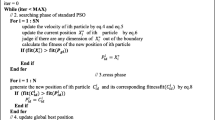Abstract
Clustering categorizes data into meaningful groups without any prior knowledge. This paper presents a novel swarm-base clustering algorithm inspired from flock movement. Many algorithms solve the problem by optimizing a cost function but ours clusters data by applying one rule on data agent movements. We demonstrated that not only this simple rule is sufficient but completely effective in accurately dividing the data into natural clusters. It is a good model of how simply nature solves complex problems. Unlike some algorithms, this one does not need number of desired cluster in advance and discovers it by itself correctly. Eight data sets were used to compare the algorithm with five well-known algorithms. K-means and k-harmonic fail to find none-Gaussian clusters and two other swarm-base algorithms suffer severely from performance but our algorithm works successfully in both cases. The result confirms the superiority of our method.
Access this chapter
Tax calculation will be finalised at checkout
Purchases are for personal use only
Preview
Unable to display preview. Download preview PDF.
Similar content being viewed by others
References
Razavi Zadegan, S., Mirzaie, M., Sadoughi, F.: Ranked k-medoids: A fast and accurate rank-based partitioning algorithm for clustering large datasets. Knowledge-Based Systems (2012)
Tari, L., Baral, C., Kim, S.: Fuzzy c-means clustering with prior biological knowledge. J. Biomed. Inform. 42(1), 74–81 (2009)
Datta, S., Datta, S.: Comparisons and validation of statistical clustering techniques for microarray gene expression data. Bioinformatics 19(4), 459–466 (2003)
Vesanto, J., Alhoniemi, E.: Clustering of the self-organizing map. ITNN 11(3), 586–600 (2000)
Wu, Z., Leahy, R.: An optimal graph theoretic approach to data clustering: Theory and its application to image segmentation. IEEE Transactions on Pattern Analysis and Machine Intelligence 15(11), 1101–1113 (1993)
Senthilnath, J., Omkar, S., Mani, V.: Clustering using firefly algorithm: Performance study. Swarm and Evolutionary Computation 1(3), 164–171 (2011)
Kalyani, S., Swarup, K.: Particle swarm optimization based k-means clustering approach for security assessment in power systems. Expert Syst. Appl. 38(9), 10839–10846 (2011)
Chen, L., Xu, X.H., Chen, Y.X.: An adaptive ant colony clustering algorithm. In: Proceedings of 2004 International Conference on Machine Learning and Cybernetics, vol. 3, pp. 1387–1392. IEEE (2004)
Veenhuis, C., Köppen, M.: Data swarm clustering. SIDM 34, 221–241 (2006)
Kazemian, M., Ramezani, Y., Lucas, C., Moshiri, B.: Swarm clustering based on flowers pollination by artificial bees. In: Abraham, A., Grosan, C., Ramos, V. (eds.) Swarm Intelligence in Data Mining. SCI, vol. 34, pp. 191–202. Springer, Heidelberg (2006)
Lumer, E., Faieta, B.: Diversity and adaptation in populations of clustering ants. In: Proceedings of the 3rd International Conference on Simulation of Adaptive Behavior: From Animals to Animats 3 (1994)
Reynolds, C.W.: Flocks, herds and schools: A distributed behavioral model. ACM SIGGRAPH Computer Graphics 21, 25–34
Reichart, R., Rappoport, A.: The nvi clustering evaluation measure. In: Proceedings of the Thirteenth Conference on Computational Natural Language Learning, pp. 165–173. Association for Computational Linguistics
Vitányi, P.M., Balbach, F.J., Cilibrasi, R.L., Li, M.: Normalized information distance, pp. 45–82. Springer (2009)
Rosenberg, A., Hirschberg, J.: V-measure: A conditional entropy-based external cluster evaluation measure. In: EMNLP-CoNLL, vol. 7, pp. 410–420
Mirkin, B.: Mathematical classication and clustering. Kluwer Academic Press (1996)
Rand, W.M.: Objective criteria for the evaluation of clustering methods. Journal of the American Statistical Association 66(336), 846–850 (1971)
Hripcsak, G., Rothschild, A.S.: Agreement, the f-measure, and reliability in information retrieval. Journal of the American Medical Informatics Association 12(3), 296–298 (2005)
Author information
Authors and Affiliations
Corresponding author
Editor information
Editors and Affiliations
Rights and permissions
Copyright information
© 2014 Springer International Publishing Switzerland
About this paper
Cite this paper
RazaviZadegan, S.G., RazaviZadegan, S.M. (2014). A Novel Clustering Approach: Simple Swarm Clustering. In: Kozielski, S., Mrozek, D., Kasprowski, P., Małysiak-Mrozek, B., Kostrzewa, D. (eds) Beyond Databases, Architectures, and Structures. BDAS 2014. Communications in Computer and Information Science, vol 424. Springer, Cham. https://doi.org/10.1007/978-3-319-06932-6_22
Download citation
DOI: https://doi.org/10.1007/978-3-319-06932-6_22
Publisher Name: Springer, Cham
Print ISBN: 978-3-319-06931-9
Online ISBN: 978-3-319-06932-6
eBook Packages: Computer ScienceComputer Science (R0)




